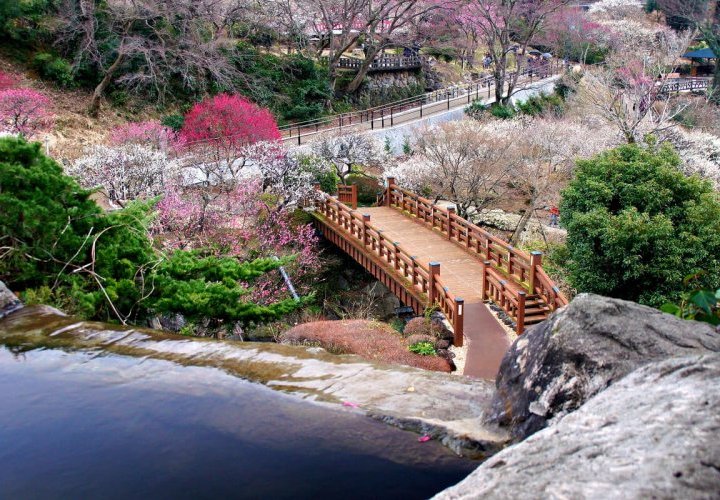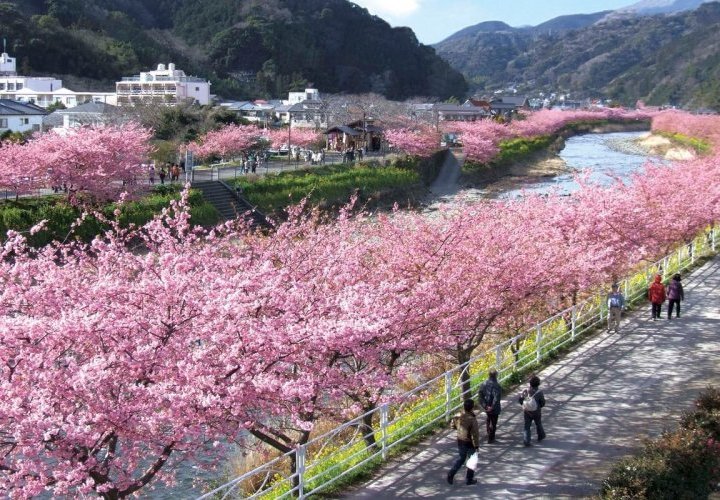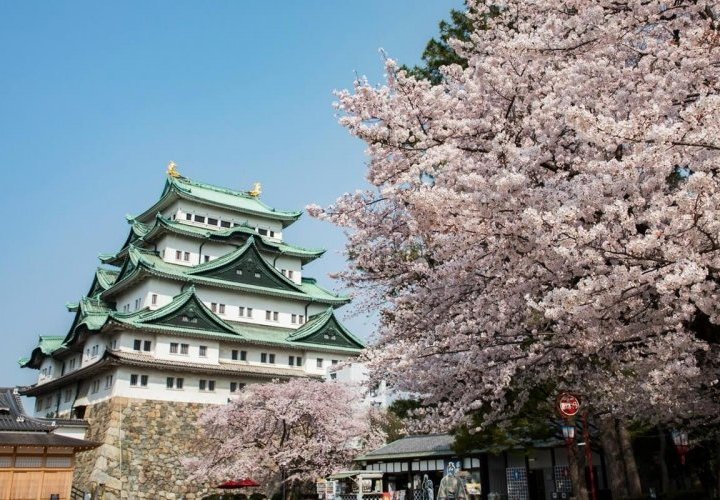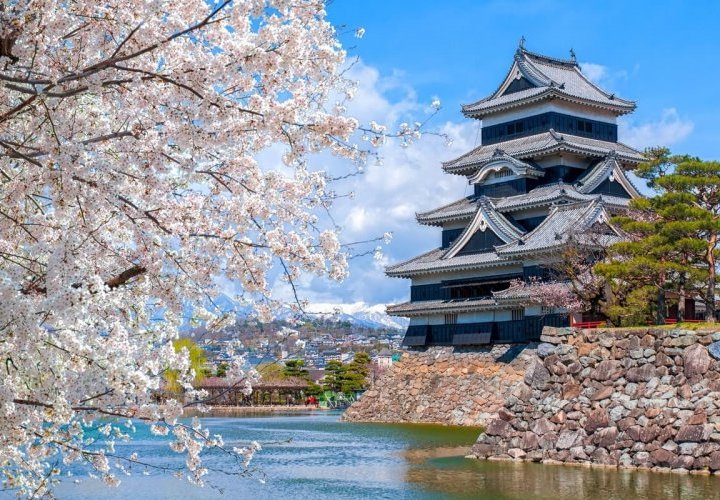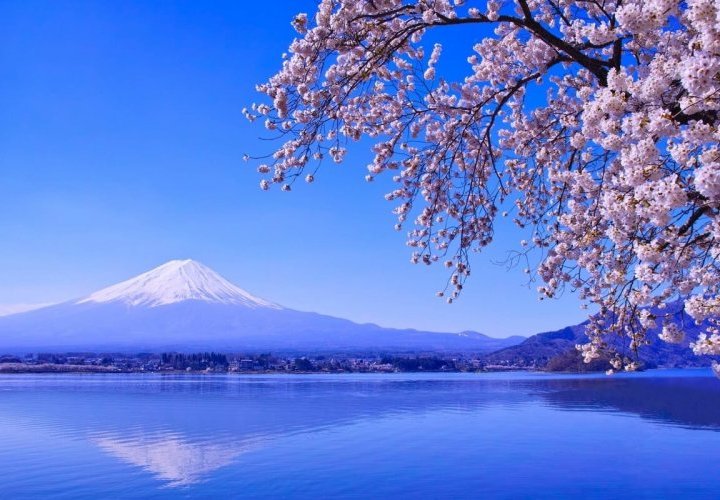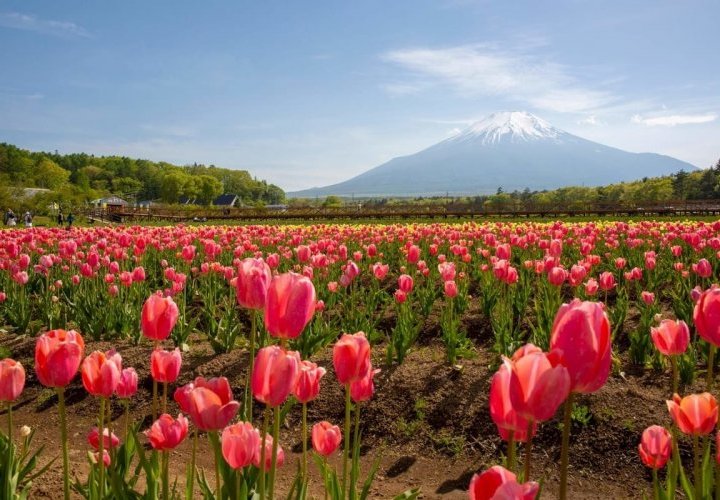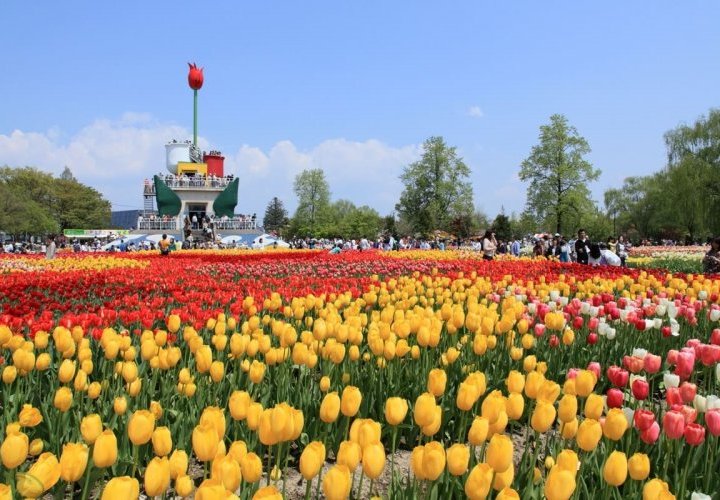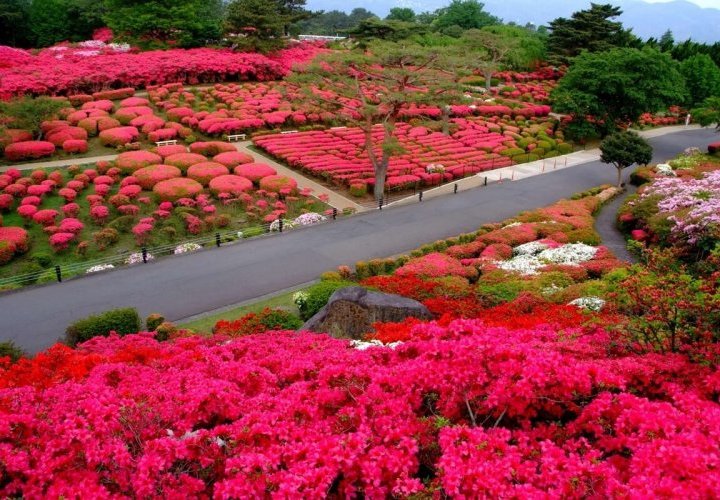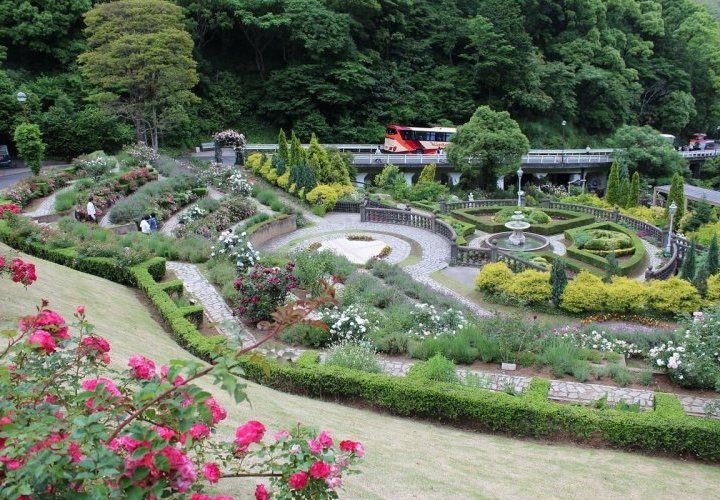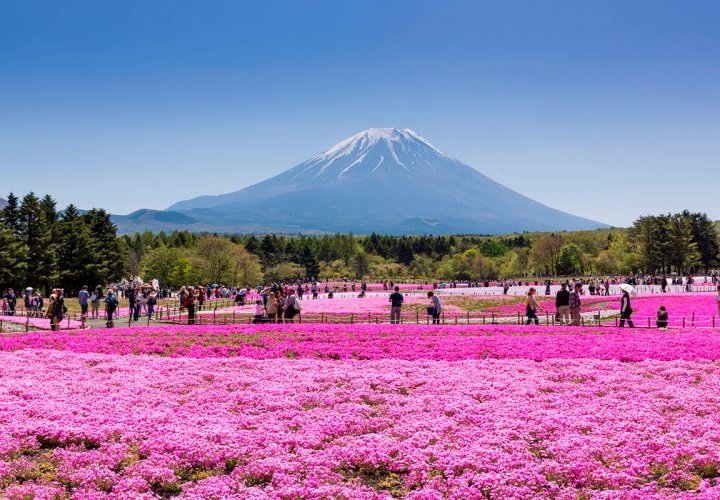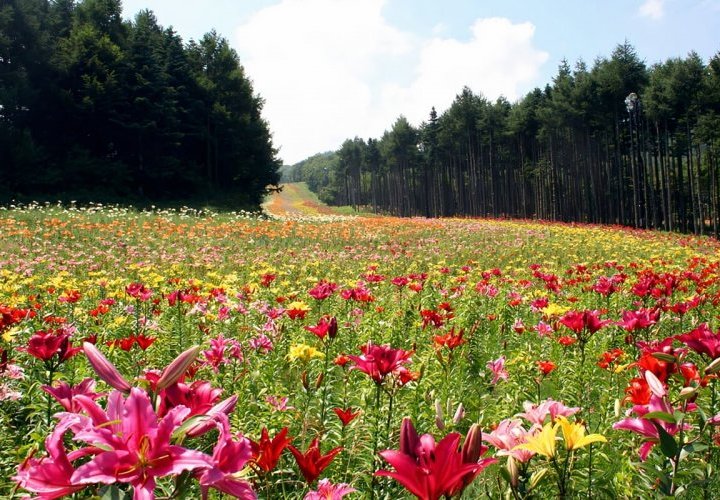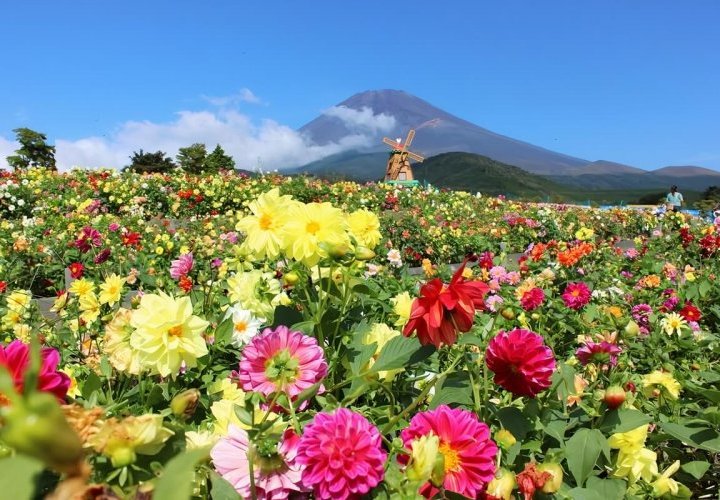Plum blossoms in Atami Plum Garden, Atami (mid-January to mid-March)
Atami Plum Garden is home to 472 plum trees of 57 kinds including “Nenashi-Ume”, “Kuyo-Bai”, “Kanichi” and “Omiya-no-Ume”, each showing different beauty. The plum trees from the garden start to blossom early and are said to be the fastest to bloom in Japan. They have different flowering times depending on the type and, for this reason, plum blossoms can be enjoyed for two months from mid-January to mid-March in the garden.
Cherry blossoms on the banks of the Kawazu River, Kawazu (early February to early March)
Kawazu boasts some of the earliest cherry blossoms in Japan from early February to early March, while the blooming season in Tokyo is from mid-March. more
Atami Plum Garden is home to 472 plum trees of 57 kinds including “Nenashi-Ume”, “Kuyo-Bai”, “Kanichi” and “Omiya-no-Ume”, each showing different beauty. The plum trees from the garden start to blossom early and are said to be the fastest to bloom in Japan. They have different flowering times depending on the type and, for this reason, plum blossoms can be enjoyed for two months from mid-January to mid-March in the garden.
Cherry blossoms on the banks of the Kawazu River, Kawazu (early February to early March)
Kawazu boasts some of the earliest cherry blossoms in Japan from early February to early March, while the blooming season in Tokyo is from mid-March. more
In comparison with the most common sakura type, Yoshino cherry in Japan, Kawazu sakura features larger petals and deep pink hue. From early February to early March, Kawazu Cherry Blossom Festival is spread over the town of Kawazu to neighbouring Mine Onsen, with the focus on the banks of the Kawazu River. There are about 8,000 sakura trees on the entire area, 800 of them growing along the river. Many food and drink stalls line the streets along the river, where you can buy local crafts and souvenirs.
Cherry blossoms at Nagoya Castle, Nagoya (late March to early April)
Nagoya Castle is one of the most famous attractions in Nagoya, and so are the cherry blossoms here. About 1,000 sakura trees of 10 kinds bloom in the castle area making a beautiful scenery with the light green roof of Nagoya Castle. At night, the cherry blossoms are illuminated and the scenery gets more mysterious.
Cherry blossoms at Four Seasons Road of Yamazaki River, Nagoya (late March to early April)
Four Seasons Road of Yamazaki River is one of Japan’s top 100 spots to view sakura. About 600 Yoshino cherry trees are spread along the 2.8 km Yamazaki riverbank offering to viewers a large space for enjoying the blooms without feeling crowded.
Cherry blossoms in Arakogawa Park, Nagoya (late March to early April)
Both 1 km long riversides of the Arako River are lined with 1,000 cherry trees blossoming from late March to early April every year. The Cherry Blossoms Festival features concerts, performances, workshops and other attractions. In the evenings, the artificial illumination shrouds the whole place under a spectacular atmosphere.
Cherry blossoms on the Nihondaira Plateau, Shizuoka (late March to early April)
There are about 2,000 cherry blossom trees on the 300-metre high hilltop of the Nihondaira Plateau, while Suruga Bay and Mt. Fuji are also in sight. Ropeway is available to the top of the Nihondaira Plateau, which is also a designated place to appreciate the stunning night view.
Tulip in Akao Herb and Rose Garden, Atami (late March to mid-April)
Akao Herb and Rose Garden spreads over 66 hectares on a hilltop overlooking the sea, with the azure waters of Sagami Bay as its backdrop. There are about 12 themed gardens where visitors can enjoy seasonal blooms of roses, tulips, cherry blossoms and a magnificent herb garden. About 100,000 tulips bloom in the garden from late March to mid-April. You can admire the marvellous view while enjoying a coffee or the signature rose ice cream at the café designed by Sakai R&D using layered cypress logs.
Cherry blossoms at the Northern Shores of Lake Kawaguchiko, Fujikawaguchiko (early to mid-April)
Cherry blossoms and Mt. Fuji are symbols of Japan and the combination of the two makes a spectacular panorama. The Northern Shores of Lake Kawaguchiko is one of the perfect places to shoot them with the lake and enjoy the beautiful landscape. There are around 300 cherry trees here, that bloom later than in Tokyo, thus making it possible to enjoy the cherry blossoms after the full bloom in Tokyo.
Cherry blossoms in Togokusan Fruits Park, Nagoya (early to mid-April)
In spite of being a place full of flowers and fruit trees with a fishing corner and a Japanese garden, Togokusan Fruits Park is hardly known among foreign visitors. Its 1,000 weeping cherry trees in bloom and its diverse fruit trees, such as apples, peaches, pears, plums and tropical kinds such as bananas, papayas, coconuts, lychees and jackfruits attract visitors from all over Japan.
Cherry blossoms at Matsumoto Castle, Matsumoto (early to mid-April)
Matsumoto Castle, designated as a National Treasure and one of the five ancient castles in Japan, offers a breathtaking view from early to mid-April with the cherry trees in bloom and the snow-capped Northern Japan Alps. About 300 cherry trees such as Yoshino cherry and Weeping cherry grow along the outer walls and moats, becoming very charming during the light-up event at night.
Cherry blossoms at Nagoya Castle, Nagoya (late March to early April)
Nagoya Castle is one of the most famous attractions in Nagoya, and so are the cherry blossoms here. About 1,000 sakura trees of 10 kinds bloom in the castle area making a beautiful scenery with the light green roof of Nagoya Castle. At night, the cherry blossoms are illuminated and the scenery gets more mysterious.
Cherry blossoms at Four Seasons Road of Yamazaki River, Nagoya (late March to early April)
Four Seasons Road of Yamazaki River is one of Japan’s top 100 spots to view sakura. About 600 Yoshino cherry trees are spread along the 2.8 km Yamazaki riverbank offering to viewers a large space for enjoying the blooms without feeling crowded.
Cherry blossoms in Arakogawa Park, Nagoya (late March to early April)
Both 1 km long riversides of the Arako River are lined with 1,000 cherry trees blossoming from late March to early April every year. The Cherry Blossoms Festival features concerts, performances, workshops and other attractions. In the evenings, the artificial illumination shrouds the whole place under a spectacular atmosphere.
Cherry blossoms on the Nihondaira Plateau, Shizuoka (late March to early April)
There are about 2,000 cherry blossom trees on the 300-metre high hilltop of the Nihondaira Plateau, while Suruga Bay and Mt. Fuji are also in sight. Ropeway is available to the top of the Nihondaira Plateau, which is also a designated place to appreciate the stunning night view.
Tulip in Akao Herb and Rose Garden, Atami (late March to mid-April)
Akao Herb and Rose Garden spreads over 66 hectares on a hilltop overlooking the sea, with the azure waters of Sagami Bay as its backdrop. There are about 12 themed gardens where visitors can enjoy seasonal blooms of roses, tulips, cherry blossoms and a magnificent herb garden. About 100,000 tulips bloom in the garden from late March to mid-April. You can admire the marvellous view while enjoying a coffee or the signature rose ice cream at the café designed by Sakai R&D using layered cypress logs.
Cherry blossoms at the Northern Shores of Lake Kawaguchiko, Fujikawaguchiko (early to mid-April)
Cherry blossoms and Mt. Fuji are symbols of Japan and the combination of the two makes a spectacular panorama. The Northern Shores of Lake Kawaguchiko is one of the perfect places to shoot them with the lake and enjoy the beautiful landscape. There are around 300 cherry trees here, that bloom later than in Tokyo, thus making it possible to enjoy the cherry blossoms after the full bloom in Tokyo.
Cherry blossoms in Togokusan Fruits Park, Nagoya (early to mid-April)
In spite of being a place full of flowers and fruit trees with a fishing corner and a Japanese garden, Togokusan Fruits Park is hardly known among foreign visitors. Its 1,000 weeping cherry trees in bloom and its diverse fruit trees, such as apples, peaches, pears, plums and tropical kinds such as bananas, papayas, coconuts, lychees and jackfruits attract visitors from all over Japan.
Cherry blossoms at Matsumoto Castle, Matsumoto (early to mid-April)
Matsumoto Castle, designated as a National Treasure and one of the five ancient castles in Japan, offers a breathtaking view from early to mid-April with the cherry trees in bloom and the snow-capped Northern Japan Alps. About 300 cherry trees such as Yoshino cherry and Weeping cherry grow along the outer walls and moats, becoming very charming during the light-up event at night.
Tulip in the Tulip Fields near Muramatsu Park, Gosen (mid to late April)
About 1,500,000 tulips grow in a vast land of 3 hectares in Gosen, 20-minute drive from Muramatsu Park. The best time to see the tulips is from mid to late April, when you can take spectacular photos in the huge tulip fields that stretch as far as the eyes can see.
Tulip in Yamanakako Hanano Miyako Park, Yamanakako (mid-April to mid-May)
Yamanakako Hanano Miyako Park is a flower field located at the base of Mt. Fuji, stretching over an area of 300,000 square metres and delighting visitors with millions of seasonal flowers. It is located really close to one of the famous Fuji 5 Lakes, Lake Yamanaka and Oshino Village, however this flower park is almost unknown. more
About 1,500,000 tulips grow in a vast land of 3 hectares in Gosen, 20-minute drive from Muramatsu Park. The best time to see the tulips is from mid to late April, when you can take spectacular photos in the huge tulip fields that stretch as far as the eyes can see.
Tulip in Yamanakako Hanano Miyako Park, Yamanakako (mid-April to mid-May)
Yamanakako Hanano Miyako Park is a flower field located at the base of Mt. Fuji, stretching over an area of 300,000 square metres and delighting visitors with millions of seasonal flowers. It is located really close to one of the famous Fuji 5 Lakes, Lake Yamanaka and Oshino Village, however this flower park is almost unknown. more
Various kinds of seasonal flowers including tulips, nemophilas, sunflowers and zinnias flourish in this flower field every month from spring through autumn. About 170,000 tulips can be admired here during the blooming season, while enjoying at the same time the glorious view of Mt. Fuji in the background.
Moss phlox at the foot of Mount Fuji, Fujikawaguchiko (mid-April to late May)
The sight of moss phlox (shibazakura in Japanese) blooming at the foot of Mt. Fuji near Lake Motosu is very impressive. About 800,000 pink shibazakura cover the vast area of 2.3 ha offering a stunning landscape with the majestic Mt. Fuji in the background. The Fuji Shibazakura Festival held at the foot of Mt Fuji is one of the most popular events in Japan during spring. Although the festival runs from mid-April to late May, the best time for viewing the moss phlox is from late April to early May.
Tulip in Tonami Tulip Park, Tonami (late April to early May)
Tonami Tulip Park is located in Tonami city near Takaoka in Toyama Prefecture. Tonami has a tulip history dating back to 1918 when the cultivation of the flower first began in the area. Currently, the city is the leading producer of tulip bulbs in Japan. About 2.5 million tulips of 600 different varieties bloom colourfully in Tonami Tulip Park where also the Tonami Tulip Fair is held. The annual tulip fair lasts for two weeks from late April to early May and includes various events and attractions, such as a Flower Fashion Show, performances, an unusual flower bed floating on a gourd-shaped pond, a Love Powerspot flower bed, a tulip-shaped observation tower, etc. The Tonami Tulip Gallery (Tulip Shikisaikan) is a large exhibition hall allowing visitors to view tulips indoor all year round. Besides displays of tulip flowers, the gallery includes a museum where you can discover useful information about tulips and their cultivation.
Azalea in Komuroyama Park, Izu (late April to early May)
Azalea (tsutsuji in Japanese) is a popular spring flower in Japan and Komuroyama Park of Izu city, Shizuoka Prefecture, is one of the best spots where you can enjoy this colourful and adorable flower. Over 100,000 azaleas of 40 kinds bloom vividly in the vast park of 35,000 square metres. The park is located 321 m above sea level around Mt. Komuro, offering an amazing panoramic view of the Izu Peninsula and Sagami Bay. The Komuroyama Park Azalea Festival is one of the biggest azalea festivals in Japan and takes place from late April to early May annually. One of the best highlights of the festival is the Azalea Tunnel located in the centre of the park, which is formed by human sized azalea trees. Several events are held during the festival, such as local delicacies tasting, sale of local products at markets and various shows. The illumination of azaleas is available at night during the festival, offering a romantic and mystical view of the flowers.
Moss phlox at Chausuyama Kogen, Toyone (early May to early June)
Chausuyama Kogen is the only ski resort in Aichi Prefecture. In spring, it offers a spectacular sight of 400,000 moss phloxes that cover the 22,000 square metre hillside. From early May to early June, the Moss Phlox Festival is held at the hilltop of Chausuyama highlands, about 1,358 meters above the sea level. You can walk through the flower fields or ride the ski lift and enjoy the view from above.
Iris in Kawazu Iris Garden, Kawazu (mid-May to early June)
Kawazu Iris Garden is one of the best iris spots in Shizuoka Prefecture. It has 12,000 irises of 60 kinds that bloom from mid-May to early June. Kawazu city is the largest producer of irises in eastern Japan and the flowers bloom earlier than in other places due to the heat from hot springs.
Rose in Akao Herb and Rose Garden, Atami (mid-May to mid-June)
Akao Herb and Rose Garden located in Atami city is one of the leading rose gardens in the world boasting 4,000 rose bushes of 600 varieties. The garden that stretches over an area of 661,000 square metres is dotted with 12 beautiful gardens filled with colourful herbs and roses. You can admire the spectacular Rose Gardens, the stunning Italian-style Herb Garden with its fountain and endless variety of herbs and the impressive Japanese-style garden. There are many small rose gardens of various themes including the English Rose Garden, the Golden Rose Garden, the Collection Garden, the Queen of the Night Garden, the Valley of Roses, the Climbing Rose Garden, the Proposal Garden and the Wedding Garden. The best time to see the roses is from mid-May to mid-June when they are in full bloom. There is also an open café where you can enjoy its signature rose ice cream.
Iris in Kamo Iris Garden, Toyohashi (late May to mid-June)
Kamo Iris Garden is located along the Prefectural Route 499 in Toyohashi city near the Kamo Shrine that is believed to have been built in the year 729 CE. The 1-hectare garden is filled with about 35,000 irises of 300 kinds. From late May to mid-June, the Kamo Iris Festival including various events such as illuminations, photography contests and concerts takes place here to celebrate the flowers in bloom.
Hydrangea in Okuyama Kogen Park, Hamamatsu (late May to early July)
Okuyama Kogen Park spans across Mt. Tonmaku in the mountain ranges north of Hamamatsu city, where different flowers in bloom can be enjoyed in all four seasons of Japan. There is a water garden with a waterfall, a spacious dog run, a golf course and other facilities allowing visitors to relax in the company of nature. About 10,000 hydrangeas of around 70 different types blanket the mountain terrain with their vibrancy.
Lily in Tanigumi Lily Park, Ibigawa (early June to early July)
About 300,000 lilies of 50 varieties, including Sukashi and oriental lilies, grow on the three hectare grounds of Tanigumi Lily Park in Ibigawa town, Gifu Prefecture. The park is only open during the lily blooming season from early June to early July. During this time, the Lily Festival is organized in the park allowing visitors to enjoy events such as Japanese kayo ballad performances, karaoke and folk performances. You can also purchase different lily varieties in pots including white Casablanca lilies and bright pink Acapulco lilies.
Moss phlox at the foot of Mount Fuji, Fujikawaguchiko (mid-April to late May)
The sight of moss phlox (shibazakura in Japanese) blooming at the foot of Mt. Fuji near Lake Motosu is very impressive. About 800,000 pink shibazakura cover the vast area of 2.3 ha offering a stunning landscape with the majestic Mt. Fuji in the background. The Fuji Shibazakura Festival held at the foot of Mt Fuji is one of the most popular events in Japan during spring. Although the festival runs from mid-April to late May, the best time for viewing the moss phlox is from late April to early May.
Tulip in Tonami Tulip Park, Tonami (late April to early May)
Tonami Tulip Park is located in Tonami city near Takaoka in Toyama Prefecture. Tonami has a tulip history dating back to 1918 when the cultivation of the flower first began in the area. Currently, the city is the leading producer of tulip bulbs in Japan. About 2.5 million tulips of 600 different varieties bloom colourfully in Tonami Tulip Park where also the Tonami Tulip Fair is held. The annual tulip fair lasts for two weeks from late April to early May and includes various events and attractions, such as a Flower Fashion Show, performances, an unusual flower bed floating on a gourd-shaped pond, a Love Powerspot flower bed, a tulip-shaped observation tower, etc. The Tonami Tulip Gallery (Tulip Shikisaikan) is a large exhibition hall allowing visitors to view tulips indoor all year round. Besides displays of tulip flowers, the gallery includes a museum where you can discover useful information about tulips and their cultivation.
Azalea in Komuroyama Park, Izu (late April to early May)
Azalea (tsutsuji in Japanese) is a popular spring flower in Japan and Komuroyama Park of Izu city, Shizuoka Prefecture, is one of the best spots where you can enjoy this colourful and adorable flower. Over 100,000 azaleas of 40 kinds bloom vividly in the vast park of 35,000 square metres. The park is located 321 m above sea level around Mt. Komuro, offering an amazing panoramic view of the Izu Peninsula and Sagami Bay. The Komuroyama Park Azalea Festival is one of the biggest azalea festivals in Japan and takes place from late April to early May annually. One of the best highlights of the festival is the Azalea Tunnel located in the centre of the park, which is formed by human sized azalea trees. Several events are held during the festival, such as local delicacies tasting, sale of local products at markets and various shows. The illumination of azaleas is available at night during the festival, offering a romantic and mystical view of the flowers.
Moss phlox at Chausuyama Kogen, Toyone (early May to early June)
Chausuyama Kogen is the only ski resort in Aichi Prefecture. In spring, it offers a spectacular sight of 400,000 moss phloxes that cover the 22,000 square metre hillside. From early May to early June, the Moss Phlox Festival is held at the hilltop of Chausuyama highlands, about 1,358 meters above the sea level. You can walk through the flower fields or ride the ski lift and enjoy the view from above.
Iris in Kawazu Iris Garden, Kawazu (mid-May to early June)
Kawazu Iris Garden is one of the best iris spots in Shizuoka Prefecture. It has 12,000 irises of 60 kinds that bloom from mid-May to early June. Kawazu city is the largest producer of irises in eastern Japan and the flowers bloom earlier than in other places due to the heat from hot springs.
Rose in Akao Herb and Rose Garden, Atami (mid-May to mid-June)
Akao Herb and Rose Garden located in Atami city is one of the leading rose gardens in the world boasting 4,000 rose bushes of 600 varieties. The garden that stretches over an area of 661,000 square metres is dotted with 12 beautiful gardens filled with colourful herbs and roses. You can admire the spectacular Rose Gardens, the stunning Italian-style Herb Garden with its fountain and endless variety of herbs and the impressive Japanese-style garden. There are many small rose gardens of various themes including the English Rose Garden, the Golden Rose Garden, the Collection Garden, the Queen of the Night Garden, the Valley of Roses, the Climbing Rose Garden, the Proposal Garden and the Wedding Garden. The best time to see the roses is from mid-May to mid-June when they are in full bloom. There is also an open café where you can enjoy its signature rose ice cream.
Iris in Kamo Iris Garden, Toyohashi (late May to mid-June)
Kamo Iris Garden is located along the Prefectural Route 499 in Toyohashi city near the Kamo Shrine that is believed to have been built in the year 729 CE. The 1-hectare garden is filled with about 35,000 irises of 300 kinds. From late May to mid-June, the Kamo Iris Festival including various events such as illuminations, photography contests and concerts takes place here to celebrate the flowers in bloom.
Hydrangea in Okuyama Kogen Park, Hamamatsu (late May to early July)
Okuyama Kogen Park spans across Mt. Tonmaku in the mountain ranges north of Hamamatsu city, where different flowers in bloom can be enjoyed in all four seasons of Japan. There is a water garden with a waterfall, a spacious dog run, a golf course and other facilities allowing visitors to relax in the company of nature. About 10,000 hydrangeas of around 70 different types blanket the mountain terrain with their vibrancy.
Lily in Tanigumi Lily Park, Ibigawa (early June to early July)
About 300,000 lilies of 50 varieties, including Sukashi and oriental lilies, grow on the three hectare grounds of Tanigumi Lily Park in Ibigawa town, Gifu Prefecture. The park is only open during the lily blooming season from early June to early July. During this time, the Lily Festival is organized in the park allowing visitors to enjoy events such as Japanese kayo ballad performances, karaoke and folk performances. You can also purchase different lily varieties in pots including white Casablanca lilies and bright pink Acapulco lilies.
Lily in Fujiten Resort Lily Park, Narusawa (mid-July to late August)
Fujiten Resort Lily Park located in Narusawa town is home to roughly 6 million lilies of 70 varieties that bloom in vivid colours at an elevation of approximately 1,300 metres on a ski slope at the foot of Mount Fuji. The park is one of the largest parks of this kind in Chubu region, where you can enjoy the beautiful view and the fascinating perfume of lilies from the middle of July to the end of August.
Dahlia at Grinpa Amusement Park, Susono (mid-July to early October)
A floral fantasy of about 30, more
Fujiten Resort Lily Park located in Narusawa town is home to roughly 6 million lilies of 70 varieties that bloom in vivid colours at an elevation of approximately 1,300 metres on a ski slope at the foot of Mount Fuji. The park is one of the largest parks of this kind in Chubu region, where you can enjoy the beautiful view and the fascinating perfume of lilies from the middle of July to the end of August.
Dahlia at Grinpa Amusement Park, Susono (mid-July to early October)
A floral fantasy of about 30, more
000 dahlias in bloom can be enjoyed at Grinpa Amusement Park, right at the base of Mt. Fuji from mid-July to early October. The shape and colour of the flowers differ depending on the variety, thus each flower is unique. Additionally, you can see 160,000 cosmos plants (late August to early October) and 300,000 marigolds (mid-September to early October). If you come from mid-September to early October, you can enjoy the combination of the three blossoming flowers! A flower festival named the “Heavenly Flower Fields” where visitors can enjoy the flowers spread out over this large site is held here. The foothills of Mt. Fuji are dyed in brilliant red, pink, yellow and white colours offering a breathtaking 360-degree panorama. If you travel with your pets, they are welcome too and you can snap a photo of you and your pet together.
Sunflower in Akeno Sunflower Field, Hokuto (late July to mid-August)
Akeno Sunflower Field is located in Hokuto, a mountainous city in the northwestern part of Yamanashi Prefecture. You can enjoy an astonishing view of over 600,000 sunflowers blooming in the vast field with the glorious Northern Alps Mountains in the background. Hokuto Akeno Sunflower Festival takes place here annually during the blooming season. During the event, you can taste local food and drinks and buy various products.
Cosmos in Yamanakako Hanano Miyako Park, Yamanakako (late August to mid-October)
Yamanakako Hanano Miyako Park is one of the best cosmos spots to reach from Tokyo. It is located near Yamanaka Lake, which is at the base of Mt. Fuji. Here, you can enjoy the marvellous view of the 300,000 square metre field full of amazing cosmos flowers together with the spectacular Mt. Fuji in the background. The best season to visit the park is from early September to mid-October, when you can see not only pink and white cosmos flowers, but also a yellow cosmos field.
Sunflower in Akeno Sunflower Field, Hokuto (late July to mid-August)
Akeno Sunflower Field is located in Hokuto, a mountainous city in the northwestern part of Yamanashi Prefecture. You can enjoy an astonishing view of over 600,000 sunflowers blooming in the vast field with the glorious Northern Alps Mountains in the background. Hokuto Akeno Sunflower Festival takes place here annually during the blooming season. During the event, you can taste local food and drinks and buy various products.
Cosmos in Yamanakako Hanano Miyako Park, Yamanakako (late August to mid-October)
Yamanakako Hanano Miyako Park is one of the best cosmos spots to reach from Tokyo. It is located near Yamanaka Lake, which is at the base of Mt. Fuji. Here, you can enjoy the marvellous view of the 300,000 square metre field full of amazing cosmos flowers together with the spectacular Mt. Fuji in the background. The best season to visit the park is from early September to mid-October, when you can see not only pink and white cosmos flowers, but also a yellow cosmos field.

